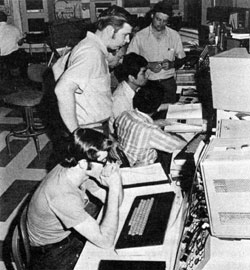Proton Beam Guided Through Entire NAL Accelerator System
The formal announcement was terse, but behind it there was almost unbelievable hard work and creativity. Physicists, engineers and technicians worked around the clock; even Nurses Dorothy Poll and Glenys Smith were on hand during the "owl shift" to observe and to assist, but, fortunately, they were not needed.
No one jumped up and down with joy; not even a champagne cork was popped. In the Control Room at the Central Laboratory area, there was an atmosphere of accomplishment, but not of celebration, because there was more work to be done in the weeks and months ahead before total victory could be acclaimed. In the Control Room, about 20 persons observed the tiny closed circuit television sets that seemed only to blink on and off, but which really were recording another milestone in the development of the National Accelerator Laboratory.
At mid-morning Wednesday, June 30, the U.S. Atomic Energy Commission and the Laboratory issued a brief statement. It read:
"A proton beam was guided through the entire National Accelerator Laboratory accelerator system for the first time at 6:44 a.m. CTD, Wednesday, June 30, 1971. The beam was accelerated to 7 BeV in the linear accelerator and the booster accelerator system and then 'coasted' through the largest component in the NAL accelerator system -- the main accelerator, which is four miles in circumference.
Present plans call for the main accelerator staff to continue beam studies until Thursday night and then to shut down for the holiday weekend. The next milestone facing the accelerator system crew is to accelerate the protons in the main ring, working up to the system's full original design energy of 200 billion electron volts."
Later, a look at the official log revealed a brief, light-hearted but significant observation by a physicist: "Only 50,000 more turns to go." Obviously the detection of the first beam through the entire NAL accelerator system was only the beginning of a new era and the beginning of the end of the first major phase of construction at NAL.
Don Young, Operations head, held several meetings after the first success. With his colleagues, he discussed various operational alternatives. One such meeting was held at 3:00 p.m. Thursday. Then it was decided to run the machine until at least midnight.
At 3:20 a.m. on Friday, July 2, 1971, Frank Cole, physicist working with Young's group, read a statement:
"Operation was shut down a few minutes ago at 3:15 a.m. During the operation, up to eight complete turns in the Main Ring were observed with some losses during this coasting. The operation is being shut down for the holiday weekend and will resume some time next week."

Oscilloscope trace of the first turn of the beam in the NAL Main Ring

In the Control Room: The Main Ring Control center was a quiet but intense locale of NAL activity last week as the first proton beam was sent around the Main Accelerator to achieve another NAL milestone. In this photo, taken a short time after the beam completed one turn through the Main Ring, several members of the NAL staff check the "evidence" in the official log book and also on the closed circuit television screens returning various data to physicists and engineers. From bottom to top they are: Barry Barnes, AI Maier, Ernie Malamud (back to camera), E.L. Goldwasser, Shigeki Mori, and Robert R. Wilson


